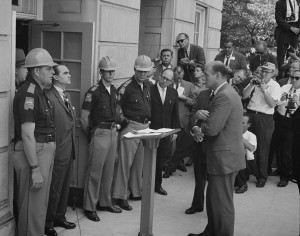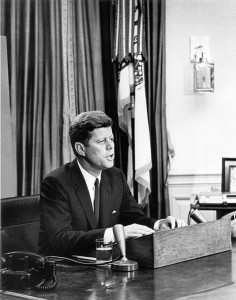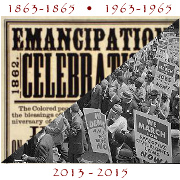The 50th anniversary of two civil rights landmarks
Posted June 11th, 2013 by James DeWolf PerryCategory: Public History Tags: Civil Rights Act of 1964, Civil rights movement, George Wallace, John F. Kennedy, Medgar Evers, University of Alabama
Today marks the 50th anniversary of two major landmarks in the civil rights movement: George Wallace’s “stand in the schoolhouse door” over desegregation at the University of Alabama, and President Kennedy’s address to the nation announcing what would become the Civil Rights Act of 1964.
“The Stand in the Schoolhouse Door”
 On the morning of June 11, 1963, Governor George Wallace of Alabama personally and physically intervened, in front of television cameras, to attempt to block the desegregation of the University of Alabama in Tuscaloosa.
On the morning of June 11, 1963, Governor George Wallace of Alabama personally and physically intervened, in front of television cameras, to attempt to block the desegregation of the University of Alabama in Tuscaloosa.
The deputy attorney general of the United States, Nicholas Katzenbach, was present in person to request that Wallace step aside. When that request was rebuffed by the governor, General Henry Graham of the Alabama National Guard, having been federalized by President John F. Kennedy, ordered the governor to stand aside. Wallace complied, after first complaining to the news cameras about this “unwelcomed, unwanted, unwarranted and force-induced intrusion” by the federal government on the affairs of Alabama.
Today, of course, we recognize the futility of this last-ditch attempt to maintain the segregation of the Jim Crow era. And we discern the future of race relations in this country, that morning in Alabama, not in the person of the governor, or the guard commander, or even the president of the United States, but in the presence of Vivian Malone and James Hood, the two young black students attempting to enter Foster Auditorium to register for classes.
Perhaps the future of race in this country can also be seen in the words of Peggy Wallace Kennedy, the daughter of George Wallace, who has begun speaking out about that experience and what legacy she herself wants to leave to her children and grandchildren:
It has taken me a lifetime to step out from the shadow of the schoolhouse door. I just found my voice. I was inspired by President Obama a lot when he said that change can come, and we need to move forward.
The President Addresses the Nation
 As inevitable as the end of desegregation may have been, the course of the civil rights movement would have been very different if not for the second, and far less scripted, event later that day.
As inevitable as the end of desegregation may have been, the course of the civil rights movement would have been very different if not for the second, and far less scripted, event later that day.
Once the standoff in Alabama was resolved, President Kennedy was not expected to follow up on the day’s events. At the last moment, however, Kennedy called the television networks and stunned his speechwriter, Ted Sorensen, by asking him to hastily draft a speech to be delivered at 8:00pm.
In his surprise speech that evening, Kennedy took an entirely new approach to the question of civil rights for a U.S. president. After noting that the University of Alabama had been peacefully desegregated that morning, the president declared civil rights to be a “moral issue” and a “revolution,” not just for the South, but for the entire nation.
Kennedy also explicitly linked civil rights for black Americans to the Emancipation Proclamation, noting that the promise of that presidential statement was still far from being fulfilled:
One hundred years of delay have passed since President Lincoln freed the slaves, yet their heirs, their grandsons, are not fully free.
They are not yet freed from the bonds of injustice. They are not yet freed from social and economic oppression. And this Nation, for all its hopes and all its boasts, will not be fully free until all its citizens are free.
In addition to this dramatic shift in rhetoric, the president used this address to announce two major policy shifts: the speeding up of desegregation, and the introduction of comprehensive civil rights legislation into the Congress, what would become the Civil Rights Act of 1964.
With a symbolic turning point for desegregation that day in Alabama, and a presidential address to the nation announcing the future Civil Rights Act of 1964, the date of June 11, 1963 became one of the most momentous in the history of the civil rights movement.
This remained true even after word spread of the horrifying turn of events just hours later, on the morning of June 12, in Jackson, Mississippi.



Leave a Reply